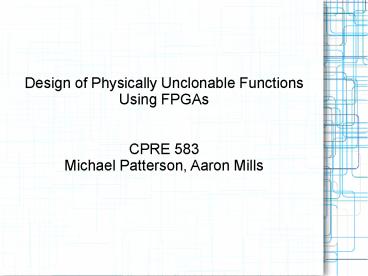Design of Physically Unclonable Functions Using FPGAs - PowerPoint PPT Presentation
Title:
Design of Physically Unclonable Functions Using FPGAs
Description:
Design of Physically Unclonable Functions Using FPGAs CPRE 583 Michael Patterson, Aaron Mills Temperature Stability Testing Same format as Consistency test Every 5C ... – PowerPoint PPT presentation
Number of Views:197
Avg rating:3.0/5.0
Title: Design of Physically Unclonable Functions Using FPGAs
1
Design of Physically Unclonable Functions Using
FPGAs CPRE 583 Michael Patterson, Aaron Mills
2
What is a PUF?
- Hardware hash function
- Uniquely identify a device
- Impossible to reverse engineer
- Modeling attacks, power spectrum analysis...
- Applications RFID, Chip Authentication, Etc.
3
Delay-Based PUF Types
- Butterfly PUF
- Requires feedback loops to be identical
4
Delay-Based PUF Types
- Arbiter PUF
- Again, issue each race track must be identical
- Tunable delay, constrain the synthesis placement,
etc...
5
Our Design
- 16 bit challenge, 8 bit response
6
Our Design
- Rationale
- Challenge partitioning
- Number of ROs
- Counter value
- Other comments
7
RO in vhdl
signal ros std_logic_vector(4 downto
0) attribute keep boolean attribute keep of
ros signal is true
8
Properties of a good PUF
- Consistency
- Uniqueness
- One-to-One
9
Consistency Testing
- One PUF, One Challenge
- PUF is given the same 16-bit challenge 32 times
- repeated for 128 randomly generated challenges.
- the percentage of responses that differ will be
calculated - the ideal value is a 0 percent change.
10
Consistency Results
The 8-bit response was correct 94.68 percent
of the time.
11
Uniqueness Testing
- One PUF, different challenges
- A single PUF is given 1024 different challenges
consisting of a Gray Code pattern (a series of
numbers that tours unique data values bychanging
only one bit at a time). - The average hamming distance between adjacent
responses will be calculated. - ideal average hamming distance is 50 percent.
12
Uniqueness Results
On average, 2.88 bits change in the response for
a one bit change in input.
13
One-to-One Testing
- Different PUFs, one challenge
- Different PUFs given the same series of 1024
challenges. - The average hamming distance between responses is
calculated. - ideal average hamming distance is 50 percent.
14
One-to-One Results
On average, 46.16 percent of the bits are
different between responses of two different PUFs
to the same challenge.
15
Temperature Stability
Why is considering temperature important? Linear
approximation ?(T) ?01 a(T -
T0)
16
Temperature Stability
- Testing
- Same format as Consistency test
- Every 5C from 10C to 65C
17
Temperature Stability
- Results
- But...most errors caused by a few inputs
Response Bit 0 1 2 3 4 5 6 7
Ham. Distance () 0.3 2 0.1 0.6 0 0 0.2 2
18
Hard Macros
Why are hard macros useful? Issues...
19
Future Work
- Hard Macro Usage
- Post processing to improve results
- Repeat same challenge several times
- Large input size for testing to increase
statistical significance of results - Research properties of different input patterns
- Optimize design to consume less space on the fpga
- Multi-phase calculation
20
References
1. An Analysis of Delay Based PUF Implementations
on FPGA, Sergey Morozov, Abhranil Maiti, and
Patrick Schaumont 2. Physical Unclonable
Functions for Device Authentication and Secret
Key Generation, G. E. Suh and S. Devadas. 3. B.
Gassend, D. Clarke, M. van Dijk, and S. Devadas.
Delay-based circuit authentication and
applications.
21
References
- 4. J. Guajardo, S. Kumar, G.-J. Schrijen, and P.
Tuyls. Physical unclonable functions and
public-key crypto for fpga ip protection. - 5. S. Kumar, J. Guajardo, R. Maes, G.-J.
Schrijen, and P. Tuyls. Extended abstract The
butter?y puf protecting ip on every fpga. - 6. M. Majzoobi and F. Koushanfar. Time-bounded
authentication of fpgas. - 7. G. E. Suh and S. Devadas. Physical unclonable
functions for device authentication and secret
key generation.































